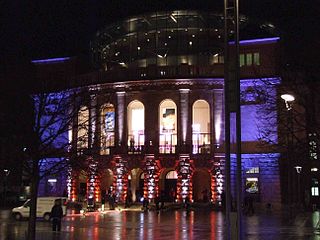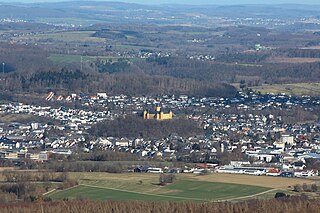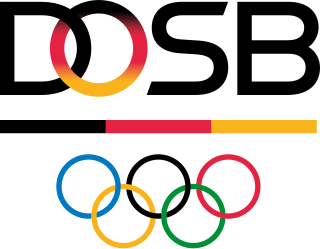Related Research Articles

Rhineland-Palatinate is a western state of Germany. It covers 19,846 km2 (7,663 sq mi) and has about 4.05 million residents. It is the ninth largest and sixth most populous of the sixteen states. Mainz is the capital and largest city. Other cities are Ludwigshafen am Rhein, Koblenz, Trier, Kaiserslautern, Worms and Neuwied. It is bordered by North Rhine-Westphalia, Saarland, Baden-Württemberg and Hesse and by France, Luxembourg and Belgium.

Nossrat Peseschkian lived in Germany since 1954. He was a specialist in neurology, psychiatry, psychotherapy and psychosomatic medicine. Peseschkian founded Positive Psychotherapy in 1968, based on a cross-cultural approach; he was also the founder of the Wiesbaden Academy of Psychotherapy (WIAP), a German-state-licensed, postgraduate institute of psychotherapy.

The Carl Zuckmayer Medal is a literary prize given by the state of Rhineland-Palatinate in memory of Carl Zuckmayer. The medal itself was fashioned by state artist Otto Kallenbach. The prize is also given with a 30 liter cask of Nackenheimer wine from region Gunderlock, a type valued by Zuckmayer. The bestowal takes place on 18 January, the anniversary of Zuckmayer's death.

Montabaur is a town and the district seat of the Westerwaldkreis in Rhineland-Palatinate, Germany. At the same time, it is also the administrative centre of the Verbandsgemeinde of Montabaur – a kind of collective municipality – to which 24 other communities belong. The town is known throughout the country for its strikingly yellow castle and its InterCityExpress railway station on the Cologne-Frankfurt high-speed rail line.

The German Olympic Sports Confederation was founded on 20 May 2006 by a merger of the Deutscher Sportbund (DSB), and the Nationales Olympisches Komitee für Deutschland (NOK) which dates back to 1895, the year it was founded and recognized as NOC by the IOC.

The raccoon, also spelled racoon and sometimes called the common raccoon to distinguish it from other species, is a mammal native to North America. It is the largest of the procyonid family, having a body length of 40 to 70 cm, and a body weight of 5 to 26 kg. Its grayish coat mostly consists of dense underfur, which insulates it against cold weather. Three of the raccoon's most distinctive features are its extremely dexterous front paws, its facial mask, and its ringed tail, which are themes in the mythologies of the indigenous peoples of the Americas relating to the animal. The raccoon is noted for its intelligence, as studies show that it is able to remember the solution to tasks for at least three years. It is usually nocturnal and omnivorous, eating about 40% invertebrates, 33% plants, and 27% vertebrates.
Rolf Wilhelm Brednich is a German Europeanist ethnologist and ethnographer (Volkskundler) and folklorist.

The Kaldenkirchen Sequoia Farm is a German arboretum that has been used as a biological institute for many years. Part of the protected area in the city of Nettetal, it is situated in the "Kaldenkirchen Grenzwald". Nettetal lies in the Lower Rhine region of Germany.

Alsenborn is a village forming part of the municipality of Enkenbach-Alsenborn within the district of Kaiserslautern in the German state of Rhineland-Palatinate. It has a population of 2,750. Until 1969 Alsenborn was an independent parish before merging with Enkenbach under the administrative reforms in the state. Alsenborn is known country-wide for its circus troupes, the football team of SV Alsenborn, which competed for promotion to the premier league in 1970, and as the home town of Fritz Walter, the 1954 captain of the German Football Team and World Cup champions.

Gerechtigkeitsspirale is a relief carving of a poem at the pilgrimage church of St. Valentin in Kiedrich, in Hesse, Germany. The text is carved in the form of a spiral on the front of one of the pews for the congregation, creating possibly the earliest known shape poem in the German language. The carving is one of several decorative designs on the pews in the church, and was created in 1510 by the master carpenter Erhart Falckener.
Georg Friedrich Backhaus is a German agricultural scientist specializing in horticulture and phytomedicine. Since 2008 he has been president of the Julius Kühn-Institut (JKI) with headquarters in Quedlinburg.

Eveline Lemke is former German politician and member of the Alliance 90/The Greens. From 18 May 2011 until 18 May 2016, she was vice minister president of Rhineland-Palatinate and Minister for Economics, Climate Protection, Energy and Regional Planning. On 27 March 2011, she was elected into the Landtag of Rhineland-Palatinate. She was the leading candidate for her party in the 2016 Rhineland-Palatinate state elections along with The Greens faction leader in the Landtag, Daniel Köbler, after having been leader of the party since 2006. As vice minister Lemke represented the state of Rhineland-Palatinate in the German Bundesrat. As author and speaker in green technological issues and Circular Economy, she founded Thinking Circular in 2017. This thinktank is listed in the Sustainable Development Goals Help Desk, a platform by the United Nations since July 2018. She is also working as consultant together with Prof. Michael Braungart, chemist and inventor of the design philosophy Cradle-to-Cradle, Martin Lees and David Wortmann (DWR-Eco-Innovation-Alliance).
Richard Klophaus is a German economist and professor for business administration, transport and logistics at the University of Applied Sciences, Worms.
Christoph-Hellmut Mahling was a German musicologist and lecturer at various universities.
Uwe Harten is a German musicologist, who works in Austria.
Beate West-Leuer is a German professor, psychotherapist, consultant and coach.

Gregor Hagedorn is a German botanist and academic director at the Natural History Museum, Berlin.
Günther Noll is a German music educator and university faculty.
Magnus Backes was a German art historian and historic preservationist. From 1983 to 1991, he succeeded Werner Bornheim gen. Schilling and Hartmut Hofrichter as the third Landeskonservator of the General Directorate for Cultural Heritage Rhineland-Palatinate Rheinland-Pfalz in Mainz.
References
- 1 2 "Forum: Dr. Ulf Hohmann". GWN-Homepage. Gesellschaft für Wildökologie und Naturschutz e.V. Retrieved 2008-07-26.
- ↑ "Presseinfos". GWN-Homepage (in German). Gesellschaft für Wildökologie und Naturschutz e.V. 2001-04-20. Retrieved 2008-07-26.
- ↑ "Forum: Weitere Veröffentlichungen". GWN-Homepage (in German). Gesellschaft für Wildökologie und Naturschutz e.V. Retrieved 2008-07-26.
- 1 2 "Hohmann, Dr. Ulf". Landesforsten Rheinland-Pfalz (in German). 2005. Retrieved 2008-07-26.
- ↑ Hohmann (2001), p. 24–25
- ↑ Hohmann (2001), p. 155
- ↑ Gehrt, Stanley D. (1994). "Raccoon social organization in South Texas".
{{cite journal}}: Cite journal requires|journal=(help) (Dissertation at the University of Missouri-Columbia) - ↑ Hohmann (2001), p. 30
- ↑ Hohmann (2001), p. 31–41
- ↑ Hohmann (2001), p. 32
- ↑ Hohmann (2001), p. 39
- ↑ Hohmann (2001), p. 104–109
- ↑ Bartussek, Ingo. "Die Ergebnisse des Forschungsprojektes "Untersuchungen zur Ökologie urbaner Waschbär-Vorkommen am Beispiel der Stadt Kassel"". Die Waschbären kommen (in German). Retrieved 2008-07-26.
- ↑ Michler, Frank-Uwe; Köhnemann, Berit A. "Projektleitung / Ansprechpartner". „Projekt Waschbär“ (in German). Gesellschaft für Wildökologie und Naturschutz e.V. Retrieved 2008-07-26.